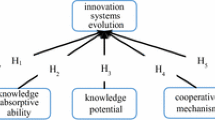Abstract
The decision-making processes of knowledge transfer are regarded as the Stackelberg leader-followers games between the core firm and partners in the technology innovation alliance. Basically, a decision-making model of knowledge transfer is established to analyze the influences of knowledge transfer decisions of the core and partners. The analysis results point out that the precondition of the existence and development of alliances is that the core firm’s knowledge marginal revenues are large enough. Partners transfer their knowledge capital according to the proportion structure of their own marginal revenues. There is a positive correlation between the knowledge transfer decisions of core firm and its own marginal revenues, and a negative correlation between the knowledge transfer decisions of core firm and the sum of partners’ marginal revenues.



Similar content being viewed by others
References
Becerra M, Lunnan R, Huemer L (2008) Trustworthiness, risk, and the transfer of tacit and explicit knowledge between alliance partners. J Manag Stud 45(4):691–713
Bloodgood JM, Salisbury WD (2001) Understanding the influence of organizational change strategies on information technology and knowledge management strategies. Decis Support Syst 31(1):55–69
Chen CJ (2004) The effects of knowledge attribute, alliance characteristics, and absorptive capacity on knowledge transfer performance. R&D Manag 34(3):311–321
Ding X-H, Huang R-H (2010) Effects of knowledge spillover on inter-organizational resource sharing decision in collaborative knowledge creation. Eur J Oper Res 201(2):949–959
Gil AE, Passino KM (2006) Stability analysis of network-based cooperative resource allocation strategies. Automatica 42(2):245–250
Gomez D, Gonzalez-Aranguena E, Manuel C, Owen G (2008) A value for generalized probabilistic communication situations. Eur J Oper Res 190(2):539–556
Grilliches Z (1979) Issues in assessing the contribution of research and development to productivity growth. Bell J Econ 10(1):92–116
Guiomar MH, Pierre C, Estelle M (2006) Deforestation and foreign transfers: a stackelberg differential game approach. Comput Oper Res 33(2):386–400
Jaffe AB (1989) Real effects of academic research. Am Econ Rev 79(5):957–970
Jiang X, Li Y, Gao S (2008a) The stability of strategic alliances: characteristics, factors and stages. J Int Manag 14(2):173–189
Jiang Z, Hu L, Tian Y (2008b) Research on stability of industrial technology innovation strategic alliance based on knowledge transfer. Long Beach, pp 1509–1515
Khamseh HM, Jolly DR (2008) Knowledge transfer in alliances: determinant factors. J Knowl Manag 12(1):37–50
Lin MH (2004) Strategic airline alliances and endogenous stackelberg equilibria. Transp Res Part E Logistics Transp Rev 40(5):357–384
Lin WB (2007) Factors affecting the correlation between interactive mechanism of strategic alliance and technological knowledge transfer performance. J High Technol Manag Res 17(2):139–155
Morasch K (2000) Strategic alliances as stackelberg cartels—concept and equilibrium alliance structure. Int J Indust Organ 18(2):257–282
Narteh B (2008) Knowledge transfer in developed-developing country interfirm collaborations: a conceptual framework. J Knowl Manag 12(1):78–91
Nielsen BB (2005) The role of knowledge embeddedness in the creation of synergies in strategic alliances. J Bus Res 58(9):1194–1204
Rond P, Hussler C (2005) Innovation in regions: what does really matter? Res Policy 34(8):1150–1172
Samaddar S, Kadiyala SS (2006) An analysis of interorganizational resource sharing decisions in collaborative knowledge creation. Eur J Oper Res 170(1):192–210
Szulanski G (2000) The process of knowledge transfer: a diachronic analysis of stickiness. Organ Behav Hum Decis Process 82(1):9–27
Weber B, Weber C (2007) Corporate venture capital as a means of radical innovation: Relational fit, social capital, and knowledge transfer. J Eng Technol Manag 24(1–2):11–35
Acknowledgments
The authors thank the editor, and two anonymous reviewers for their comments and constructive suggestions. We are grateful to the National Science Foundation Committee of P.R. China for financial support (70872025).
Author information
Authors and Affiliations
Corresponding author
Rights and permissions
About this article
Cite this article
Jiang, Zs., Hu, Ly. & Chen, Kk. Decisions of knowledge transfer in technology innovation alliance: a stackelberg leader-followers model. Oper Res Int J 10, 231–242 (2010). https://doi.org/10.1007/s12351-009-0070-6
Received:
Revised:
Accepted:
Published:
Issue Date:
DOI: https://doi.org/10.1007/s12351-009-0070-6




